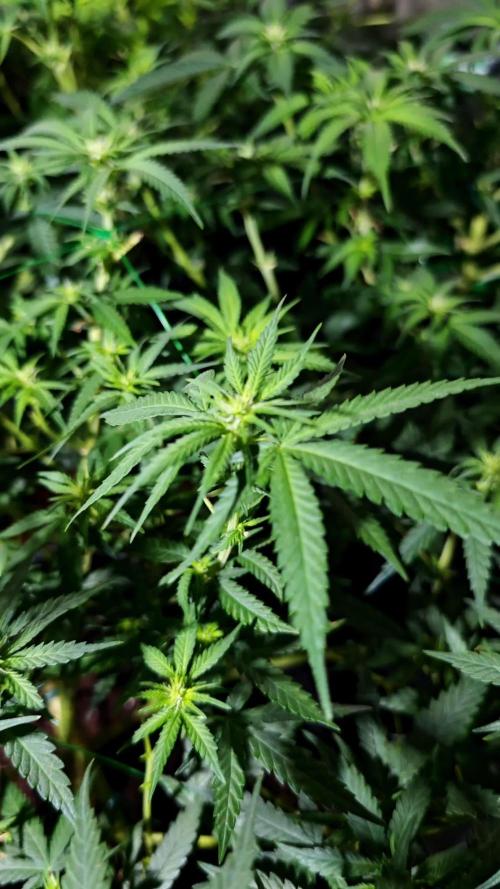The Grow Awards 2026 🏆 



























Likes
Comments
Share


@BlueGrass
Follow
Day 49: Today I changed the light schedule to 12/12. Notice some nute burn signs 3 days ago, gave plain water last feeding, Runoff was 369ppm/Ph:6.4.
They seem to be very sensitive over 600ppm and start burning.
Day 52: Feeding day today: 1ml Calmag, 1.5ml Silica, 5ml Micro, 2ml Gro, 5ml Bloom, 2.5ml Humic acids + a scoup of great white. Diluted to 540ppm. Ph: 6.5 / Runoff: 700ppm, Ph: 5.8. The girls are starting the stretch.
Day 54: Today I did some more training with those cheap bending clips I found on aliexress. Stretch seems fast!
Likes
17
Share


@Mr_nugs_lover_David
Follow
She's looking super beat ful and healthy, getting that perfect bush shape that I'm looking for, let's see what we can do guys! 💚🌱✌️
Likes
16
Share


@OrganicPower
Follow
Week 6 flower, half way there! Buds are starting to fill in now and getting some decent frost. A couple of tops are getting more light than others, and fattening a bit more and looking real nice. It looks like there is some purple starting to come out at the tops. She is strong and will go as fast as the soil and environmental conditions will allow her to. Hand watered in Gaia Green Soluble Seaweed Extract 0-0-17, otherwise water drip is running on same schedule. Just using straight tap water that sits in a 30 gallon reservoir with a submergible water pump running 24/7 breaking surface and aerating water. Water comes out the tap @ 7ph and less than 15ppm. So I don’t do nothing to it, I drink it:) Thanks for the view 🤜 Have a great week!
Likes
5
Share


@Unkraut
Follow
nice resinous strain, with strong scent and quite hard hitting high!
check www.sr-organics.com for some topnotch 5 in 1 fertilizer!
root, growth, bloom, micro-organisms, enzymes & vitamins all in one!
CODE: "Unkraut10" for 10% Discount! 😊
Likes
199
Share


@CRiSPrGrow
Follow
These came down 11 weeks to the day from seed , this is them on their last day here. Wet weight is 😂 😂 😂 😂 😂 😂 was not expecting so much, it will last me HOURS ! these got wet trimmed now they're on the mat drying , the smell is typical american sweet candy ... was it fun? yes , yes it was fun ! what a plant this one is, my tallest one at 100cm, averaging 85cm , wet weight is.... gonna wait for dry weight, before i jinx it could be dense could be loose ! looks dense + not expecting to loose more than 50% it's all in the cure now ! 🚀
Likes
44
Share


@Roberts
Follow
Bubba Kush Mintz Autoflower is doing great. I think I have a pest issue in the grow room. So I am treating her with neem oil. I will repeat a spray and wash off treatments a few times this week. Hopefully it stops them, and my plant can be happy. She didn't have them directly that I can tell. But neighbor plants do have some issue. It is my last ditch effort to treat them prior to them flowering. Neem is gross on buds. Beside that she got lollipopped and defoliated. Looking good till neem wrecks the leaves. Thank you Aeque Genetics, Athena, and Spider Farmer. 🤜🏻🤛🏻🌱🌱🌱
Thank you grow diaries community for the 👇likes👇, follows, comments, and subscriptions on my YouTube channel👇. ❄️🌱🍻
Happy Growing 🌱🌱🌱
https://youtube.com/channel/UCAhN7yRzWLpcaRHhMIQ7X4g
Likes
59
Share


@Jsammy09
Follow
8-26 (Day 70)- Have the feeding corrected from last week now and everything has been pretty stable. Not had any real issues with the temps or RH, the dehumidifier is keeping things perfect. I have been checking the back left plant to see where the trichomes are and they are still all pretty much clear. That plant seems to be a bit ahead of the others, but will just continue to monitor and feed regularly (Around 4-5 gallons a day to the res). Monday will be switching to the full tilt instead of the bulky b. These girls are so sticky and sweet smelling. I am super excited for these girls to finish and see how I've done quality wise with my first grow and already looking forward to the next run and correcting some mistakes ive made this run.
As always any tips and recommendations always welcome!
Likes
9
Share


@Dthebudguy
Follow
Few weeks to go it’s looks great cola development noce sweet piney mix of smells triche are beautiful
Likes
7
Share


@ChitownCannaChica
Follow
So the bud pretty much matched the size of the pot! Super tiny grow at 80ml of soil! Pretty frosty and dense considering the size of the pot! Smells like lemon too!
Just chopped her down and will have a harvest report on my assuming 4 grams of dried bud! Fun tiny grow!
✌️💚🌿💨
Likes
13
Share


@knicko
Follow
Jetzt sieht man deutlich das die Ladys sich auf die Blüten Produktion konzentrieren nächste Woche werden sie nochmal etwas entlaubt.
Dazu haben die einen ordentlichen Stretch hingelegt bin beeindruckt bis jetzt sind zum gluck auch keine Probleme aufgetreten bin sehr zufrieden mit der Sorte bis jetzt.
Likes
3
Share


@HiLlama
Follow
All look good. Very bushy. Giving them full dose of nutes and high light intensity. No stress signs.
Likes
22
Share


@AwfulBuddy
Follow
Hello everybody
week of fear 😅
The bad news is that I have hermies in my tent, the "good news" is there are only 2 plants out of a total of 8 ...
unfortunately one of these is one from my 3 Lemon OG, the biggest and most beautiful of course
Sprayed a lot of water to sterilize the pollen and chimped the bananas and sacs that i could see
Turned off the ventilation and sprayed water daily and crossed my fingers 🤞
Apart from that everything is going well 😁🍌😅
Thank for stoppin by and keep it growing 🍀💪
Processing
Likes
38
Share


@OutForReal
Follow
Song of the week : Eminem - Venom
-------
Day 31 - Not transplanted yet but she will be soon settle in a 7L pot like my Gorilla Girl. I decided to top her today And I made a short vid to show you how.
Likes
92
Share


@DogDoctorOfficial
Follow
Week 7 Flower Report – The Masterpiece Garden Unfolds
🌱 Introduction
Welcome back to the most thrilling chapter of our journey yet! Week 7 of flower is here, and the garden has transformed into a paradise of unique beauty and diversity. Every plant has its own personality, showcasing the results of all the hard work, dedication, and love poured into this run. Let’s dive into the details and celebrate these girls like never before—because they deserve it!
🌸 Plant-by-Plant Breakdown
Papaya Zoap
The rebel queen of the garden, aiming for the stars with her towering structure. Her dense, frosty white nugs sparkle like diamonds, and her leaves are fading to a stunning yellow hue—a clear sign she’s ready to shine. Her aroma is captivating, leaving no doubt she’s going to be a showstopper.
Gorilla Melon
Standing tall as the second in command, this beauty is all strength and vigor. Her vibrant green foliage cradles thick, frosty buds that exude a fragrance worthy of her name. A true contender for the title of MVP.
RS11
This one’s a frost factory! Long, elegant buds dripping in trichomes, with leaves gracefully fading to yellow as she transitions toward the finish line. Her balanced stature and impeccable structure make her a dream to cultivate.
Green Papaya
The frostiest of them all, her sugar leaves are curling under the weight of so much resin. Every glance reveals a shimmering coat of trichomes that’s hard to believe. If frost were a competition, she’d already have the gold medal!
Mandarin Squeeze
Dark and mysterious, this beauty stands out with her rich, deep green tones and impressively dense buds. Her flowers feel like rocks, and her aroma hints at a citrusy explosion waiting to happen.
Punch Pie
What can we say about this heavyweight? Her large, dense buds are jaw-dropping, and her presence in the tent is commanding. She’s proving to be a genetic masterpiece, delivering beyond expectations.
🌞 Environmental Mastery
This week, we’ve begun the slow decline of PPFD to 750, keeping reds and UVs strong while easing back on whites—a calculated move to guide these girls into the final stages. The room’s stats speak volumes:
• Temps: 27.8°C with RH at 64.8%.
• CO2: 800 ppm for consistent growth energy.
• Reservoir: PH 6.16, TDS 791, temp 21°C.
• Soil Stats: TDS 669, temp 22°C.
Even the fun facts are worth noting: leaf temps are ranging between 26.6°C and 24.2°C, while the LED bars are holding steady at 38°C, and the ICL-300 at 35.6°C. Aero Fan at 23°C and the filter output at 24.7°C highlight the precision and control in this room, all thanks to the incredible TrolMaster ecosystem.
💧 Feeding and Nutrient Update
Our transition from organic minerals to a solo mineral approach has been a game-changer. These girls are thriving! Here’s the recipe this week:
• System Clean: 0.25 ml/L.
• RO Water Conditioner: 0.8 ml/L.
• All-in-One Liquid: 1.75 ml/L.
• K-Boost: 0.5 ml/L.
• Regulator: 0.15 ml/L.
This blend is bringing out the best in each plant, delivering unparalleled frost, density, and aroma. The stability of the pH, thanks to minerals, has made life simpler while pushing the plants toward peak performance.
🌟 Reflecting on Progress
It’s a joy to walk into this room and witness the results of months of effort. Each plant is delivering on its promise, and the smells, colors, and trichome production are truly next-level. The journey has been demanding, but the rewards are sweeter than ever. The curiosity to see how they finish is at an all-time high!
💬 Shoutouts and Community Love
As always, massive gratitude to the sponsors that make this possible:
• TrolMaster for precise environmental control.
• Aptus Holland for top-tier nutrients.
• Cannakan for their unwavering support.
• Pro-Mix Soil for a robust foundation.
• Seed Banks for the incredible genetics.
To the Grow Diaries community, our followers, lovers, haters, and everyone in between—thank you for being part of this journey. Your engagement fuels the passion to keep growing, learning, and sharing.
📣 Call to Action
If you haven’t already, check out our YouTube and Instagram for exclusive content and updates. Don’t forget to hit that like button, subscribe, and ring the bell so you never miss a beat. Join us for the next episode, where we’ll dive into super-cropping and give the room another round of defoliation as these girls keep reaching for the finish line.
Let’s keep growing, learning, and celebrating this beautiful process. 🌱✨
Growers Love,
Your Grateful Gardener
Discount Codes so you can save big on your next check out 💚💚💚
Kannabia - DOGDOCTOR 30% off
SeedsmanSeeds - DOGDOCTOR 10% off
CannaKan- DOGDOCTOR 15% off
terpyz.eu - DOCTOR 15% off
The Neutralizer - PORKIT5-DOG 15% off
Fast Buds - DOGDOCT 15% off
As always thank you all for stopping by, for the love and for it all , this journey of mine wold just not be the same without you guys, the love and support is very much appreciated and i fell honored and so joyful with you all in my life 🙏
With true love comes happiness 💚🙏 Always believe in your self and always do things expecting nothing and with an open heart , be a giver and the universe will give back to you in ways you could not even imagine so 💚
Friendly reminder all you see here is pure research and for educational purposes only
Growers Love to you all 💚💚💚

































